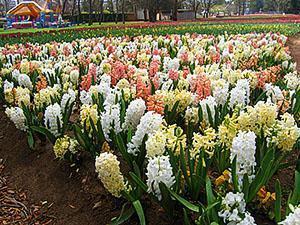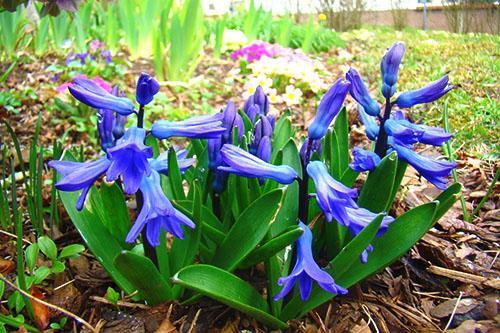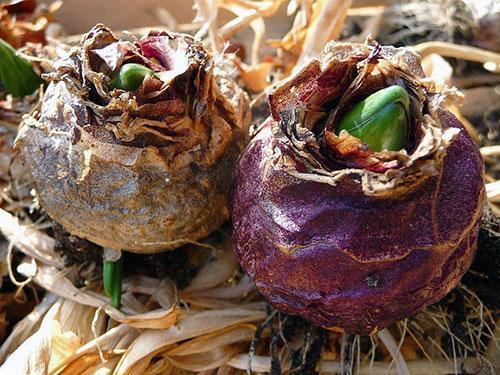Fragrant hyacinths: planting and care in the open field
 Natives of the Mediterranean and Southeast Asia, hyacinths bloom in early spring, striking with the aroma spreading in the air and a riot of color from white and all shades of blue to yellow and even deep burgundy.
Natives of the Mediterranean and Southeast Asia, hyacinths bloom in early spring, striking with the aroma spreading in the air and a riot of color from white and all shades of blue to yellow and even deep burgundy.
South of the North Caucasus, fragrant flowers are found even in the wild. On the mountain slopes and in the valleys, you can see arrows with blue or pink buds making their way from under the snow. It is not difficult to grow hyacinths in the open field, subject to a mild winter and frost-free soil.
Appearing above the ground, the bright green glossy leaves of the plant gradually open up, and a cluster inflorescence with 20-30 buds begins to rise from the middle. The flowers of modern varieties of hyacinth are tubular, funnel-shaped or bell-shaped, they can be ordinary and double, and always have an unusually rich aroma.

The choice of planting material
 Hyacinths are typical bulbous plants. Perennial bulb of this type:
Hyacinths are typical bulbous plants. Perennial bulb of this type:
- fully formed by the age of 4–6;
- has a spherical shape with a prominent neck;
- consists of numerous scales, the inner ones are dense and fleshy, and the upper ones are thin and outwardly similar to parchment.
The growth of the bulb is due to the regeneration bud formed in the core, which consists of several leaf buds and the future peduncle. Adult bulbs 5–6 years old at the bottom under storage scales form the rudiments of daughter bulbs - children.
 Moreover, depending on the variety of hyacinth, its bulbs can have different sizes. As a rule, bulbs producing double flowers are smaller than usual.
Moreover, depending on the variety of hyacinth, its bulbs can have different sizes. As a rule, bulbs producing double flowers are smaller than usual.
- If hyacinths are to be cultivated in the open field, by the time of planting the bulb should be elastic, at least 4 cm in diameter and consist of several surface scales, 6-10 accumulation scales and a fully formed bud.
- On the outer surface of the planting material there should be no mechanical damage, traces of mold, diaper rash or lethargy.
- Looking at the bottom of a quality bulb, you can see two-millimeter root buds.
- The diameter of a quality bulb is one and a half times the size of the bottom.
Such planting material will not only successfully root and overwinter, but will give abundant flowering in the spring.
Selection of a place for growing hyacinths in the open field
 A competent choice of a place for planting hyacinths in open ground and caring for plants before and after flowering is the key to a long spring flowering.
A competent choice of a place for planting hyacinths in open ground and caring for plants before and after flowering is the key to a long spring flowering.
The area where hyacinths are to grow should be well lit, which is easy to provide in spring, when there is still little foliage. But you will have to take care of protecting the flower garden from the wind.
Many gardeners make the mistake of planting bulbs under tree tops or near tall shrubs. On the one hand, such large vegetation will really save the inflorescences from the cold wind and will not shade until the foliage blooms. On the other hand, when the time comes to dig up hyacinths after flowering in the garden, the bulbs may not have enough nutrition to replenish their strength, which will affect their quality.
- Hyacinths prefer loose soil. It is better to mix clay soil or black soil with peat or river sand.
- The abundance of high-quality organic matter positively influences the growth of bulbs and the quality of flowering, but feeding with fresh manure can harm hyacinths.
- The acidity of the soil should not exceed 6.5 units, if the pH level is higher, lime flour is added to the soil.
Hyacinth bulbs react extremely poorly to waterlogging. If the groundwater at the site approaches the surface closer than half a meter, high ridges are arranged for planting hyacinths or powerful drainage is needed. To ensure the outflow of spring or rain moisture, a slight slope is sometimes made.
All preparatory work for planting hyacinths in the open field and caring for bulbs is best done at the end of summer. In a month or two, the soil will settle, and the autumn rooting of the bulbs will be faster and easier.
Planting hyacinths
 The soil under the hyacinths is dug 40 cm and at the same time the following is added per square meter:
The soil under the hyacinths is dug 40 cm and at the same time the following is added per square meter:
- 10-15 kg of well-rotted manure or humus;
- sand and peat, depending on the type and condition of the soil;
- 250 grams of limestone or 15 grams of magnesium sulfate;
- 200 grams sifted wood ash or 30 grams of potassium sulfate;
- from 60 to 80 grams of superphosphate.
If hyacinths are to be grown in open ground on sand, poor in minerals and organic matter, it is recommended to increase the amount of potassium and magnesium applied by one and a half times. The roots of the plant collect moisture and nutrition within a radius of 15–20 cm from the bulb. Therefore, the planting holes are made approximately of this size, deepening the bottom of the hyacinth by an average of 15 cm.
The smaller the planting material, the higher the bulbs are embedded in the soil and the thicker they are in the flower bed.
In low-lying areas, hyacinths can be planted on a layer of sand, slightly pressing the bulb into it. This will protect the roots and the entire plant from rotting and possible infections. Flowering can be accelerated by planting bulbs on high ridges, which with the onset of spring will warm up much faster than a flat area.
Planting dates for hyacinths for cultivation in the open field
 In most regions of Russia, hyacinths can be planted in the ground from early September to mid-October.
In most regions of Russia, hyacinths can be planted in the ground from early September to mid-October.
- If the bulbs hit the ground earlier, or the fall turns out to be unusually warm, the plants start growing and die when frost sets in.
- If you are late with planting, the bulbs will not have time to root by the time the soil is frozen.
Nevertheless, the bulbs can be embedded in the soil in the first weeks of November. To do this, the landing site must be covered with foliage or other suitable material in advance and covered with a film. The soil will keep warm, and the bulbs trapped in it will begin to grow properly.
For the winter, it is better to shelter the planting sites of hyacinths from frost with the help of mulch from peat, sawdust, foliage or spruce branches. It will be necessary to remove the shelter in early spring, so as not to damage the emerging shoots.
Outdoor cultivation and care of hyacinths
 After planting hyacinths, outdoor care is reduced to regular feeding, loosening the soil, weeding and watering, especially during a set of buds and flowering.
After planting hyacinths, outdoor care is reduced to regular feeding, loosening the soil, weeding and watering, especially during a set of buds and flowering.
- Immediately after the emergence of sprouts, hyacinths need the first feeding at the rate of 30 grams of ammonium nitrate per square meter.
- The second fertilization falls on the period of blooming of the buds. In this case, not only 20 grams of ammonium nitrate per meter is applied under the hyacinths, but also 30 grams of potassium chloride and 40 grams of superphosphate.
- When flowering is over, the plantation is fertilized at the rate of 40 grams of superphosphate and the same amount of potassium chloride per square meter.
All top dressing is applied to the aisles or the space between plants, covering 10 cm, and then the plantation is watered. And caring for hyacinths after flowering in the garden also begins with watering, which is extremely necessary in the first two weeks after the flower stalks dry.
Hyacinth care after flowering and bulb harvesting
 The bloom of hyacinths is magnificent, but fleeting. After drying the peduncles, the plant quickly loses its decorative effect.When the hyacinths have faded, what to do next in the garden? First of all, especially if the plantings of spring bulbs are combined with some other ornamental crops, the location of the hyacinths should be noted. After all, soon, when the leaves droop, it will be extremely difficult to find them. Then, plants that restore strength after flowering need high-quality watering and feeding.
The bloom of hyacinths is magnificent, but fleeting. After drying the peduncles, the plant quickly loses its decorative effect.When the hyacinths have faded, what to do next in the garden? First of all, especially if the plantings of spring bulbs are combined with some other ornamental crops, the location of the hyacinths should be noted. After all, soon, when the leaves droop, it will be extremely difficult to find them. Then, plants that restore strength after flowering need high-quality watering and feeding.
If in a Mediterranean climate the bulbs tolerate winter well and again delight with bright arrows of the inflorescences, then in the middle zone of heat during the dormant period, hyacinths are clearly lacking. So, do you need to dig up hyacinths every year? Yes, it is precisely such a measure in the middle lane that will help create the necessary conditions for the bulbs for the formation and development of the bud of compensation and the rudiments of the future flower arrow.
If healthy bulbs of hyacinths in a temperate climate, without digging for the summer, are left for wintering in the ground, their flowering next year will be much weaker than before. Only gardeners in the Kuban, North Caucasus, Crimea and the south of the Black Earth Region can not burden themselves with the annual digging of bulbs, and then only with a fairly hot summer. When to dig up hyacinths after flowering in the garden?
The best time to harvest the bulbs is in the last decade of June or early July. By this time, the leaves turn noticeably yellow and weaken at the base, now they will be easy to remove.
Storing hyacinth bulbs
 When the bulbs are free of soil, rinsed and dried:
When the bulbs are free of soil, rinsed and dried:
- they are examined, separating sick or damaged specimens during excavation;
- separate children requiring rearing;
- planting material is treated with pests and diseases for bulbs.
Then, for a week, the bulbs are kept at a temperature of about + 18–20 ° C in a ventilated room and placed in paper bags or containers in 1–2 layers.
Caring for hyacinths after flowering in the garden and storing bulbs turns out to be the most serious undertaking for a grower.
During this time, the covering scales of the hyacinths dry up, the plant acclimates and is ready for the next stage of storage, when for two months the bulbs should be at a temperature of about + 30 ° C, sufficiently high humidity and good ventilation. A month before planting, the air temperature is lowered to +17 ° C, so that the planting material can more easily transfer the upcoming planting of hyacinths into the open ground.